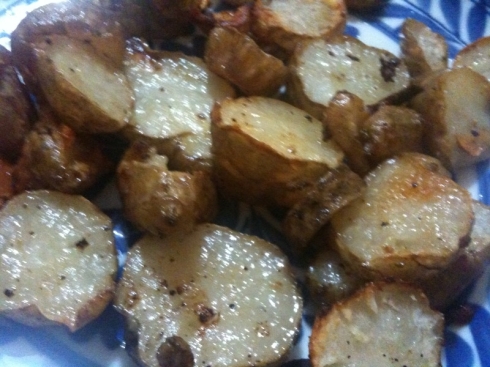Is there anything better than a pipping hot fried oyster? It’s sweet and briney juices just burst in your mouth after you bite through it’s crispy and buttery envelope, all contrasted by the lemony, tangy taste of homemade tarter sauce–Mmm mmm mmm!
I love fried oysters so much that I asked Santa to bring me some for Christmas–and lucky me, his elf Jenna (my wonderful sister-in-law) delivered! (this tells you how behind I am on my blog posts!)
Anyway, these oysters were so delicious they really were little, pipping hot Christmas miracles. If you love fried oysters too, here’s how to create your own little fried Christmas miracles:
Ingredients for Homemade Roasted Red Pepper Remoulade:
- 2 eggs
- 1 tspn Dijon mustard
- 1 cup of olive oil
- 2 lemons
- 1 tspn minced garlic
- 1/2 tspn anchovy paste
- 1 tbspn Worcester sauce
- Tabasco sauce
- 1 7.5 oz can of roasted red peppers
- salt and pepper

Check the seafood counter at your local grocery store for freshly shucked oysters by the pint. Jenna found these ones at Costco.
Ingredients for fried oysters:
- 1 can of Wondra flour (or another brand of very fine flour)
- Cayenne powder
- Paprika powder
- salt and pepper
- 2 pints of freshly shucked Oysters (Jenna used Willapoint–for some great info on Oyster varieties I recommend checking out the Oysterpedia iPhone app from one of my favorite restaurants, Mermaid Inn)
Directions for Red Pepper Remoulade:
- Separate the yolks and whites of 2 eggs and, in a large mixing bowl add the 2 yolks to 1 tspn of Dijon mustard.
- While whisking the yolks and mustard vigorously, slowly drizzle in about 1 cup of olive oil. After 2-3 minutes of whisking the mixture will emulsify into a mayo. It will be thick, tight, and pasty.

Tip: to keep your bowl stationary, use a dish towl to create a "nest" for your mixing bowl that will anchor it while you whisk.
- Zest 2 lemons and add the zest to the mayo, then cut the lemons in half and add the juice of the lemons to the mayo as well. This will both loosen up the sauce, so it gets to the right dipping consistency, and add a nice tangy flavor.
- Chop and mince 3-4 garlic cloves until you have about 1 tspn of minced garlic. Stir the minced garlic, and 1/2 tspn of anchovy paste, into the mixture.
- Add 1 tbspn of Worcester sauce (or to taste) and 6 shots of Tabasco sauce (or to taste) to the mixture.
- Taste the mixture, then add salt and pepper to taste. The consistency at this point will be that of an aioli.
- Open 1 7.5 oz can of roasted red peppers, chop and mince them. Add them to the sauce.

Tip: IIf the sauce is too thin for your liking after adding the roasted red peppers, you can add some sour cream or mayo to thicken it up.
Ok, that’s the sauce! Now for the oysters…
Directions for making fried oysters:
- First, pour in 2 quarts of peanut oil into a deep frier (or pot on the stove) and begin to heat. I like using peanut oil for frying because it has a high smoking point (the temperature to which an oil can be heated before it smokes and discolors—indications of decomposition) which means that it won’t absorb or transfer unsavory flavors into your meal.
- Then, create the breading mixture by pouring enough Wondra flour into a glass baking dish to coat the oysters, about 3-4 cups.
- Season your flour by adding salt and freshly cracked pepper, as well as a few dashes of cayenne and paprika powder.
- Take your 2 pints of freshly shucked oysters and drain some of the liquid off (fun fact–oyster “liquid” is caused oyster liquer). Then, place your oysters into the flour mixture, coat, and toss.

- Once your oil has reached 350 degrees F, you’re ready to fry! Before you begin, you may want to prepare a plate with paper towel on it to receive the fried oysters.

- One at a time, shake any extra flour off of your coated oysters (to keep your oil fresh you want to make sure that the oyster is evenly coated, but there is no extra breading). Then, slip them into the hot oil, making sure not to overcrowd the frier (that way the temp of the oil will stay stable and the oysters will cook quickly and evenly).
 Once the oysters are fried, let them rest for a few seconds on a paper towel, to drain off any additional oil. You’ll know they’re done when they crisp up and turn a nice, golden brown. Enjoy!
Once the oysters are fried, let them rest for a few seconds on a paper towel, to drain off any additional oil. You’ll know they’re done when they crisp up and turn a nice, golden brown. Enjoy!










































































